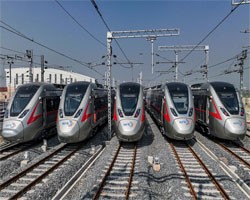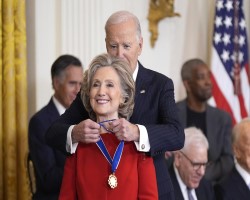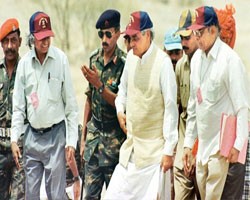Banking Current Affairs
TABLE OF CONTENTS |
| National |
|---|
|
|
|
Why in News?
Prime Minister Narendra Modi inaugurated a 13-kilometre section of the Namo Bharat Regional Rapid Transit System (RRTS) corridor, connecting Sahibabad in Ghaziabad to New Ashok Nagar in Delhi. This marks the expansion of the operational stretch to 55 km, reducing travel time between Delhi and Meerut to just 40 minutes. Key Highlights Inauguration Details: PM Modi boarded the train from Sahibabad to New Ashok Nagar and booked a QR ticket via UPI. The inauguration included the first underground section of the corridor, featuring Anand Vihar as a major transit hub. Operational Stretch: The corridor now spans 55 km with 11 stations, including 6 km of underground track. Passenger operations on the new section commenced at 5 pm, with trains available every 15 minutes. Features of the RRTS Corridor: Stations: 16 Namo Bharat stations, with additional 9 stations for the Meerut Metro. Connectivity: Interchanges with Delhi Metro’s Blue and Pink Lines at Anand Vihar and New Ashok Nagar. Fare: Rs 150 for a standard coach and Rs 225 for a premium coach (New Ashok Nagar to Meerut South). Future Developments: Further sections, including New Ashok Nagar to Sarai Kale Khan and Meerut South to Modipuram, will become operational by June. The full corridor will span 82 km from Sarai Kale Khan to Modipuram, Meerut. Significance Environmental Impact: Projected to remove over 1 lakh private vehicles from roads, reducing carbon emissions by 2.5 lakh tonnes annually. Commuter Benefits: Reduces travel time by one-third, enhancing convenience for over 50 lakh commuters already served. Economic and Urban Connectivity: Strengthens Delhi-Meerut integration with transformative transit solutions. Note: India's First Vande Metro Renamed Namo Bharat Rapid Rail Prime Minister Narendra Modi inaugurated India's first Namo Bharat Rapid Rail (formerly Vande Metro) connecting Ahmedabad and Bhuj. This service, aimed at redefining intercity commuting, will begin operations on September 17 from Ahmedabad to Bhuj and on September 18 in the reverse direction. The train will halt at nine stations and offer a comfortable journey at a cost of ₹455. Key Features and Benefits The Namo Bharat Rapid Rail is equipped with 12 air-conditioned coaches, advanced safety systems like KAVACH, smoke/fire detection, and modular interiors. It has a capacity of 1,150 passengers and provides accessibility features like Divyangjan-friendly toilets. The train covers a 360-kilometer distance in 5 hours and 45 minutes at a speed of 110 km/h. This initiative promises to boost local tourism, create jobs, and enhance connectivity in Gujarat. |
| Awards |
|
|
|
The 82nd Annual Golden Globe Awards were held on January 5, 2025, at The Beverly Hilton, Beverly Hills, California. The ceremony celebrated exceptional talent in the film and television industries, marking a historic moment with Nikki Glaser becoming the first woman to host the event solo. Below are the major winners and highlights:
Top Winners in Film Best Actor (Drama): Adrien Brody, The Brutalist. Best Actress (Drama): Fernanda Torres, I’m Still Here. Best Director: Brady Corbet, The Brutalist. Best Motion Picture (Drama): The Brutalist. Best Original Song: El Mal from Emilia Pérez by Clément Ducol, Camille, and Jacques Audiard. Best Animated Film: Flow. Best Non-English Language Film: Emilia Pérez. Top Winners in Television Best Actor (Drama): Hiroyuki Sanada, Shōgun. Best Actress (Comedy): Jean Smart, Hacks. Best TV Series (Drama): Shōgun. Best TV Series (Comedy): Hacks. Best Limited Series: Baby Reindeer. Notable Mentions Best Supporting Actress (Film): Zoe Saldaña, Emilia Pérez. Best Supporting Actor (Film): Kieran Culkin, A Real Pain. Cinematic and Box Office Achievement: Wicked. Best Performance in Stand-Up Comedy: Ali Wong, Single Lady. |
|
|
|
Why in News?
Argentinian football legend Lionel Messi was awarded the US Presidential Medal of Freedom, the highest civilian honor in the United States, by President Joe Biden on January 5, 2025. The award recognized Messi’s contributions to sports and global culture. Although Messi could not attend the ceremony due to scheduling conflicts, the honor marked a historic moment in his illustrious career. Significance of the Presidential Medal of Freedom The Presidential Medal of Freedom is the highest civilian honor in the United States, established in 1945 by President Harry S. Truman and later renamed by President John F. Kennedy in 1963. The medal is awarded to individuals who have made exceptional contributions in areas such as: Security or national interests of the US. World peace. Cultural, public, or private endeavors. The medal features a white star on a red pentagon, surrounded by five gold eagles, with a blue circle containing 13 gold stars at the center. Other Honorees in 2025 President Biden recognized 19 public figures for their lifetime achievements across politics, entertainment, and sports. Notable awardees included: Hillary Clinton (Democratic leader). George Soros (philanthropist). Robert F. Kennedy (posthumously). Jane Goodall (anthropologist). Denzel Washington (actor). Biden also honored Republican leader Mitt Romney, showcasing bipartisan recognition. Here’s the full list: José Andrés Bono Ashton Baldwin Carter Hillary Rodham Clinton Michael J. Fox Tim Gill Jane Goodall Fannie Lou Hamer Earvin “Magic” Johnson Robert F. Kennedy Ralph Lauren Lionel Messi Bill Nye George W. Romney David M. Rubenstein George Soros George Stevens, Jr. Denzel Washington Anna Wintour About the Award Process The selection process for the Presidential Medal of Freedom is broad, with the President having the authority to choose recipients based on recommendations or personal initiative. Past awardees reflect the political and cultural priorities of the awarding administration. Legacy of the Award Over the years, recipients have included: Rosa Parks (civil rights activist). Bill Gates (Microsoft co-founder). Oprah Winfrey (talk show host). Muhammad Ali (boxing legend). Elvis Presley (music icon). 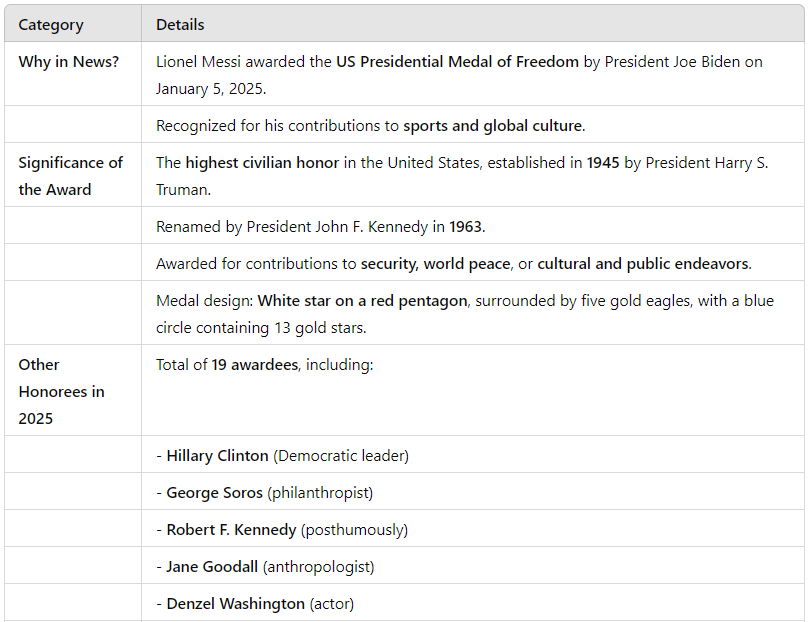 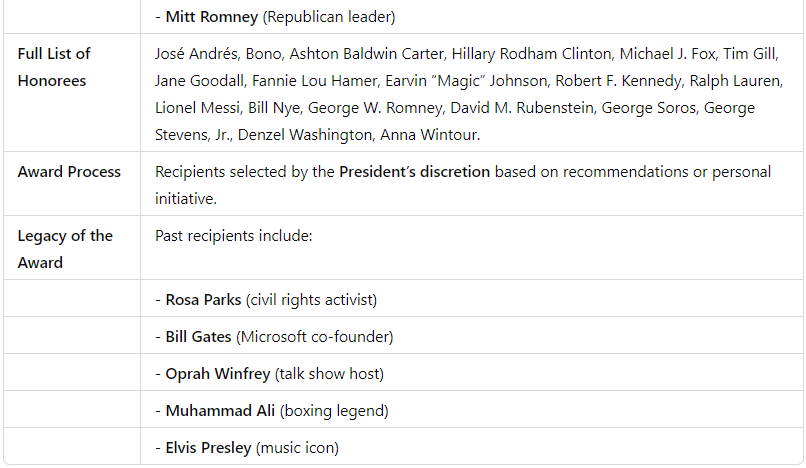
|
| Deaths |
|
|
|
Why in News?
Veteran scientist Dr. R Chidambaram, celebrated as the architect of India’s nuclear program and instrumental in the Pokhran nuclear tests of 1974 and 1998, passed away at the age of 88. His contributions to India’s scientific and technological advancements have left an enduring legacy. What are the Key Facts About Dr. R Chidambaram’s Contributions? Background: Dr. Chidambaram, born in 1936, graduated from Presidency College, Chennai, and the Indian Institute of Science, Bengaluru. Throughout his illustrious career, he held several prestigious positions, including: Director of Bhabha Atomic Research Centre (1990–1993) Chairman of the Atomic Energy Commission and Secretary, Department of Atomic Energy (1993–2000) Principal Scientific Advisor to the Government of India (2001–2018) Chairman of the Board of Governors, International Atomic Energy Agency (IAEA) (1994–1995) Key Achievements: Played a critical role in developing India’s nuclear capabilities, particularly through the Pokhran nuclear tests. Spearheaded mega science projects like the National Supercomputing Mission, the quantum technologies mission, and the Laser Interferometer Gravitational Wave Observatory (LIGO) India project. Established the National Knowledge Network for high-speed connectivity among research institutions and rural technology laboratories. Accolades: Honored with the Padma Shri (1975) and Padma Vibhushan (1999). Received honorary doctorates from multiple universities and was a fellow of eminent science academies worldwide. What is the Significance of His Legacy? Dr. Chidambaram’s work transcended the boundaries of nuclear science. His vision encompassed holistic national progress, integrating scientific advancements with economic growth and security. His leadership in scientific collaboration and policymaking laid the foundation for India’s position as a global scientific leader. Colleagues and peers, including former ISRO Chief K Kasturirangan and ex-CSIR DG Shekhar Mande, praised his grounded nature and ability to inspire across generations. His legacy continues to influence India’s scientific and technological endeavors. Way Forward Build on his vision by supporting mega science projects and fostering collaboration between academia and industry. Continue integrating scientific advancements into national development strategies. Promote innovation in science and technology to uphold India’s global leadership in key areas like nuclear energy, quantum technology, and supercomputing. 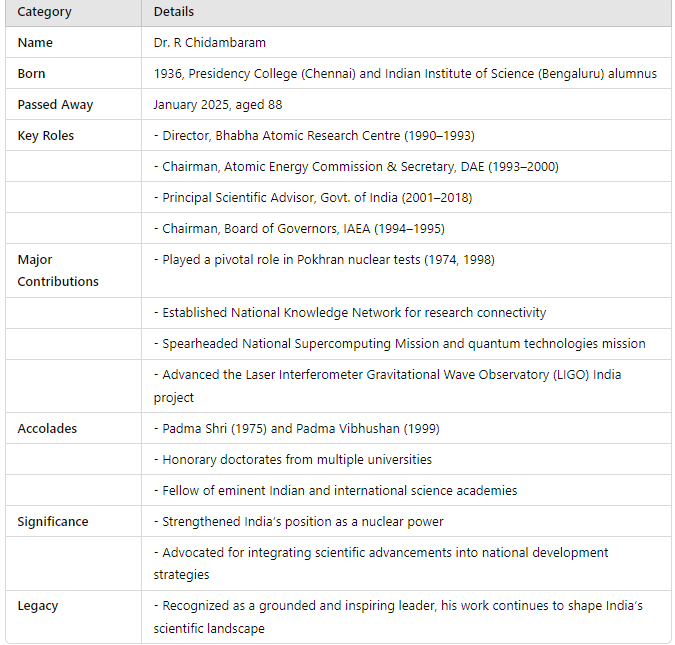
|
|
|
|
Frequently Asked Questions (FAQs) in Competitive Exams:
1. Who was Dr. R Chidambaram? A) A former President of India B) A nuclear scientist and architect of India’s nuclear programme C) An ISRO scientist specializing in space missions D) A pioneer of Indian agriculture Correct Answer: B) A nuclear scientist and architect of India’s nuclear programme 2. Which nuclear tests did Dr. R Chidambaram play a key role in? A) Pokhran-I (1974) and Pokhran-II (1998) B) Operation Shakti and Agni-V test C) Kargil War Nuclear Response D) None of the above Correct Answer: A) Pokhran-I (1974) and Pokhran-II (1998) 3. During which years did Dr. Chidambaram serve as the Principal Scientific Advisor to the Government of India? A) 1990–1993 B) 1993–2000 C) 2001–2018 D) 2018–2025 Correct Answer: C) 2001–2018 4. Which prestigious awards did Dr. R Chidambaram receive for his contributions? A) Bharat Ratna and Padma Vibhushan B) Padma Shri and Padma Vibhushan C) Nobel Prize and Padma Shri D) None of the above Correct Answer: B) Padma Shri and Padma Vibhushan 5. What was one of the major mega science projects Dr. Chidambaram supported during his tenure? A) Chandrayaan-3 B) Laser Interferometer Gravitational Wave Observatory (LIGO) India C) Mangalyaan Mission D) Mission Gaganyaan Correct Answer: B) Laser Interferometer Gravitational Wave Observatory (LIGO) India |
|
|
|
Key Highlights:
Tomiko Itooka’s Passing: Tomiko Itooka, the world's oldest person, passed away on December 29, 2024, at the age of 116 years and 220 days. She died of natural causes at a nursing home in Ashiya, Hyōgo Prefecture, Japan. Recognition as the World’s Oldest Person: In August 2024, Tomiko was recognized as the world’s oldest living person by Guinness World Records after Maria Branyas Morera (117) passed away. She was presented with the World’s Oldest Person trophy by LongeviQuest representatives on her 116th birthday and received an official certificate from Guinness in September. Early Life: Born on May 23, 1908, in Osaka, Japan, Tomiko was the second of three children and the eldest daughter. She attended an all-girls high school, a rare opportunity during that time. Family and Career: Married at 20, Tomiko had four children: two daughters and two sons. During World War II, at the age of 32, she managed the office of her husband’s textile factory while caring for her children. Legacy and Significance: Tomiko’s long life spanned over a century of historical and cultural changes in Japan and the world. Her story serves as an inspiration, reflecting resilience and adaptability through significant global events such as World War II and Japan's post-war recovery. Trivia: Tomiko’s record-breaking lifespan was meticulously documented by organizations like Guinness World Records and LongeviQuest, which maintain databases on supercentenarians. 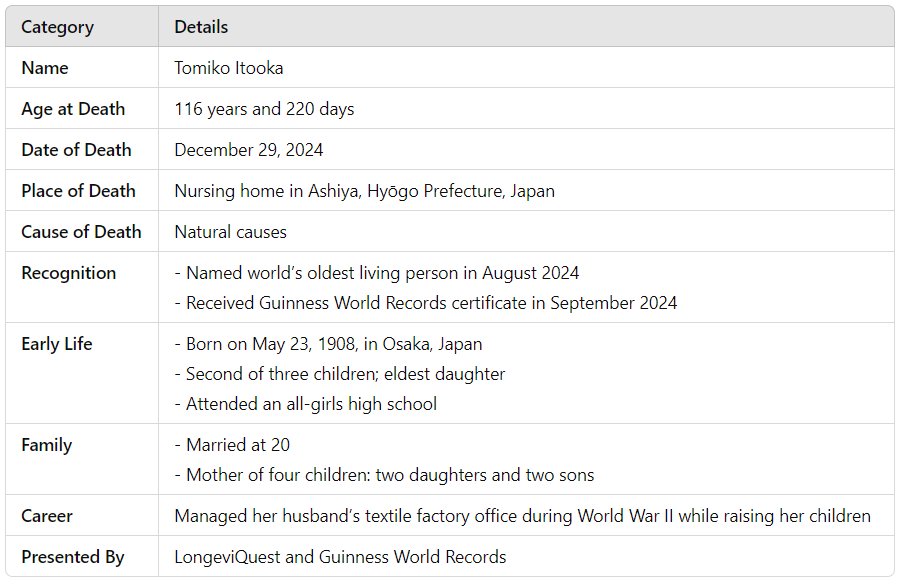
|
|
|
|
Frequently Asked Questions (FAQs) in Competitive Exams:
Q: Who was recognized as the world’s oldest living woman before passing away at the age of 116? A) Maria Branyas Morera B) Kane Tanaka C) Tomiko Itooka D) Jeanne Calment Correct Answer: C) Tomiko Itooka |
|
<< 6-Jan-25
|
|
|
